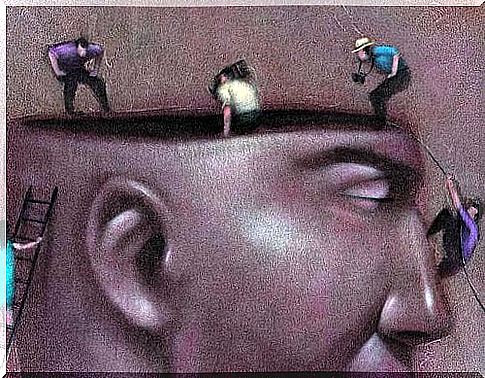The Art Of Lying To Oneself (self-deception)

The word self-deception refers to the phenomena of lies to ourselves. This is one of the great traps of the mind. Self-deception is found in those situations where we try to convince ourselves of a reality that is false, but we do so unconsciously.
The difference between lying and self-deception is that in lying the person is aware that he is not telling the truth. On the other hand, in self-deception, one accepts an erroneous reality as true, but without being aware of it.
In other words, the one who deceives himself / herself does not realize that he / she is doing it, or at least he / she does not always realize it: this is where the power of self-deception. Since we don’t realize it, self-deception deploys its power, in a way that we might call silent and chameleonic.
There are different types of self-deception, some more common than others. Moreover, each of them has different psychological effects. We will describe the four most common types of self-deception and their main psychological effects.
1. Functional self-deception
Functional self-deception is seen in situations in which the person lies to themselves while trying to convince themselves that their decision is correct. The best-known example of functional self-deception is that of the fable of the Fox and the Grapes.
In this fable, the fox characterized by its cunning feels attracted by a succulent bunch of grapes and tries to reach it by jumping several times. After several unsuccessful attempts, the fox gives up and faces his frustration by lying to himself. He convinces himself that he no longer wants to eat grapes, thinking that the bunch was not ripe enough.
The self-deception described in the fable of the Fox and the Grapes is called functional self-deception. It has a very clear function (and this is why it bears this name): the act of lying is very useful to the fox because it thus avoids feeling unwell after having failed to meet its food needs. .

The problems of functional self-deception
Short-term functional self-deception is adaptive; in the long term, however, it is neither positive nor beneficial. The resulting psychological effect is because the person decides to turn a truth (not being able to achieve a goal) into a lie that reassures them (this goal is not worth it).
According to psychologist Giorgio Nardone, any good intention, by dint of being repeated, becomes negative and counterproductive. In other words, anything that is functional and is prolonged to excess or taken in large doses, produces the opposite effect to that desired.
This way, the person who uses functional self-deception does not take any risks and stays in their comfort zone consistently. Because instead of preparing to acquire the necessary skills to achieve the goal she wants, she continues to lie to herself, thinking that what she wanted is no longer as valuable or no longer deserves as we make efforts to achieve it.
“Lying is a language game that needs to be learned, just like any other.”
-Ludwig Wittgenstein-
2. Give value to believe
The self-deception called “giving value to believe” arises from the need to end cognitive dissonance. It is characterized by the belief that if something takes a lot of money, time or effort, then we value it much more than something we haven’t paid so much for. This is why, for example, we give more importance to belonging to a group in which we have had difficulty entering. Any other group, in comparison, would be of little value.
In situations where the person has to put a lot of effort into achieving a goal, whether that goal is important to them or not, their attention is selectively focused on anything that confirms that their goal is of value. So she ends up believing that her goal is important to justify all the efforts made. Otherwise, the dissonance we were talking about at the beginning would appear.
Where does self-deception come from?
Since, psychologically, human beings cannot keep for very long a contradiction in their cognitive system (beliefs, thoughts and ideas) and their behavioral system (actions and behaviors), self-deception “gives of value to believe ”appears as a way of resolving the contradiction.
The main psychological effect of this self-deception is that the person continues to make efforts to achieve a goal that often does not correspond to their system of principles and values. It is a self-deception that has an expiration date because its effect does not last forever. In the long run, the person comes to realize this deception and, in a way, feels disappointed.
3. Comforting self-deception
Comforting self-deception is the star of self-deception and is commonly seen in people with unhealthy jealousy. The consoling lie is found in situations where the person lies to make an external agent feel guilty and to be pitied.
Some examples of consoling self-deception would be to think that one has a phobia because “my mother transmitted her fear of dogs to me” or to think “I am very jealous because my little one friend gives me reasons to be ”. These are thoughts that the person frequently exteriorizes in order to find solace.

So, consoling self-deception provides protection for self-esteem and ego. She makes us believe that nothing that is happening is our fault and that we are victims of the situation. On the one hand, this is a positive fact because very often we are not 100% responsible for the circumstances we face. However, resorting to causes of the past and to factors external to us immobilizes us in the face of change.
The trap of consoling self-deception
The consoling lie protects us. The problem with protection that lasts too long is that it keeps us from growing psychologically. The psychological effect of this self-deception is to prevent us from facing the issues that make us feel bad and to confirm to us that it is impossible to overcome them.
4. Lying to others to convince oneself
One of the more subtle ways to deceive yourself is to lie to others in order to lie to yourself personally. Here we are referring to those situations where the person conveys stories, situations and perceptions that are biased. At the beginning, we are aware of this small distortion of reality then, little by little, the person ends up being absorbed by his story and his character.
“Whoever tells a lie does not know what a heavy task he has started because he will have to invent twenty more so that the first is finally credible.”
-Alexander Pope-
If this mechanism of lying to others is repeated several times, the lie is transformed into truth, even for the one who created it. One possible explanation for this phenomenon lies in the fact that the brain adapts to dishonesty and that the lie is experienced as a reality.
It is as if the person forgot that they had constructed a false truth. Even in the face of empirical evidence of their own lie, these individuals continue to deny reality, not for lack of honesty, but because of the effect of self-deception.
No one is immune to self-deception, it is a very common psychological phenomenon and, to some extent, normal. Being free from all lies requires a great deal of personal reflection. Diving inside our being, getting to know our values, ideals and desires is the first step to protect ourselves from any self-deception and to devote ourselves to goals that we really want to achieve.








